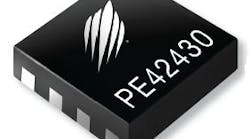Silicon CMOS was once dismissed as a technology with limited practical use at RF and microwave frequencies. But as CMOS foundries have improved their feature resolution and repeatability, CMOS has been pushed well through microwave frequencies and even past 60-GHz millimeter-wave frequencies. Peregrine Semiconductor Corp. (www.psemi.com) is one of the firms that has consistently supported the use of CMOS, and they recently strengthened their position with the introduction of two more high-frequency switches based on their proprietary UltraCMOS® technology.
Unveiled at the International Microwave Symposium (IMS) in Montreal, Canada, the two new offerings are the PE42430 single-pole, three-throw (SP3T) switch and the PE42540 single-pole, four-throw (SP4T) switch. The former is usable from 100 MHz to 3 GHz, while the latter operates from 10 Hz to 8 GHz.
The two compact switches are based on the latest version (STeP5) of the company’s patented UltraCMOS silicon-on-sapphire (SOS) technology, a unique version of silicon-on-insulator (SOI) technology. In addition to its place as a semiprecious gem, sapphire has two properties that make it suitable for use with electronic devices and circuits: It has low electrical conductivity for use as an insulating substrate for high-performance circuits, plus it has high thermal conductivity for effective dissipation of heat in high-power circuits.
The model PE42430 switch (see figure) is ideal for applications in the 2.4-GHz band, including in Bluetooth and wireless-local-area-network (WLAN) products. There is no need for a drain-voltage (VDD) pin since the drain voltage is derived from the switch control input ports; an on-chip CMOS decode logic function facilitates a three-pin CMOS control of the switch positions. The PE42430 switch exhibits typical insertion loss of 0.45 dB at 1.0 GHz and 0.55 dB at 2.5 GHz.
Model PE42430 is a SP3T switch fabricated with silicon-on-sapphire technology for low loss and high isolation from 100 MHz to 3 GHz.
The typical isolation between ports is 40 dB at 1.0 GHz and 30 dB at 2.5 GHz. The switch leverages the firm’s HaRP™ technology enhancements for high linearity, reaching an input third-order-intercept (IIP3) of +66 dBm. It has return loss of typically 22 dB at 1.0 GHz and 18 dB at 2.5 GHz. It can handle input power levels as high as 1 W (+30 dBm), with 0.1-dB compression occurring at that level.
The high-speed switch offers switching speed of typically 500 ns from 50% of the control signal to 10% or 90% of the final RF value. The turn-on time, which is measured from when the switch is activated from an unpowered condition to within 10% or 90% of a final RF value, is typically 1.5 µs. Video feedthrough, which is measured by terminating all ports and measuring the peak level of transient signals while switching logic states, is typically 10 mV. The switch provides excellent electrostatic-discharge (ESD) immunity, with a rating of 4500 V per the human body model (HBM) and 250 V per the machine model (MM) on all ports.
The SP3T switch draws power supply current of typically 130 µA from supplies of +3.0 to +5.5 VDC. The PE 42430 is designed for operating temperatures from −40 to +85ºC and is supplied in an eight-lead, 1.5 x 1.5 mm DFN package.
The higher-frequency model PE42540 is a single-pole, four-throw (SP4T) absorptive switch with a frequency range of 10 Hz to 8 GHz. It features insertion loss of only 0.8 dB at 3 GHz, 1.0 dB at 6 GHz, and 1.2 dB at 8 GHz. It is designed with four symmetric ports, achieving isolation between ports of 45 dB at 3 GHz, 39 dB at 6 GHz, and 31 dB at 8 GHz. It is designed for input power levels of +30 dBm, has a typical 1-dB compression point of +33 dBm, and IIP3 performance of typically +58 dBm. The switching time is typically 8 µs.
Like the PE42430, the SP4T model PE42540 is very rugged in terms of ESD tolerance, with HBM ratings of 2 kV for the RF input port and 1 kV for all other pins. Model PE42540 is supplied in a 32-lead 5 x 5 mm QFN package. P&A: $0.69 each (PE42430) and $4.87 each (PE42540); both 10,000 qty.
Peregrine Semiconductor Corp., 9380 Carroll Park Dr., San Diego, CA 92121; (858) 731-9400, FAX: (858) 731-9499, e-mail: [email protected], www.psemi.com.

